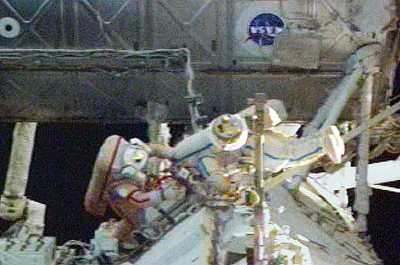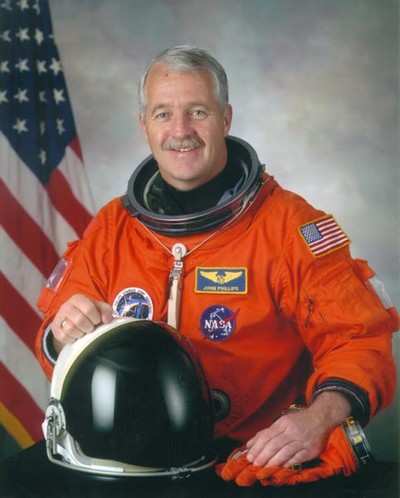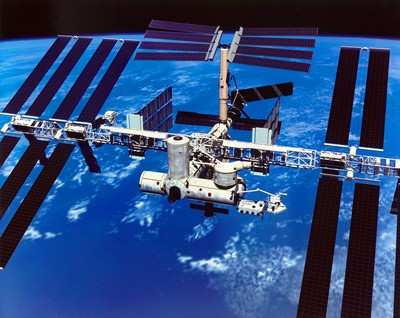NASA, Xerox to Demonstrate 'Virtual Crew Assistant'
Intelligent conversation with robots -- long the bread and
butter of science fiction authors -- soon may take another step
closer to reality for astronauts on the International Space
Station.

Scientists from NASA Ames Research Center in California's
Silicon Valley and Xerox Corporation will demonstrate a
sophisticated, voice-operated computer system on June 26 at the
Association for Computational Linguists' 25th annual meeting at the
University of Michigan, Ann Arbor. Called Clarissa, the system was
developed in an effort to ease astronaut workload.
"Clarissa is a fully voice-operated 'virtual crew assistant,'
enabling astronauts to be more efficient with their hands and eyes
and to give full attention to the task while they navigate through
the procedure using spoken commands," said Beth Ann Hockey, project
lead on the team that developed Clarissa at NASA Ames.
Plans call for astronaut John Phillips to complete the Clarissa
training procedure onboard NASA's International Space Station as
early as June 27 in preparation for later use of Clarissa.

"This will be the first use of the system in space," Hockey
said.
Clarissa is "hands-free" and responds to astronauts' voice
commands, reading procedure steps out loud as they work, helping
keep track of which steps have been completed, and supporting
flexible voice-activated alarms and timers.
Astronauts now perform about 12,000 complex procedures to
maintain life-support systems, inspect space suits, conduct science
experiments, perform medical exams and other routine tasks.
"Just try to analyze a water sample while scrolling through
pages of a procedure manual displayed on a computer monitor while
you and the computer float in microgravity," challenges astronaut
Michael Fincke, who recently completed a six-month stay on the ISS.
"To be able to speak to the system and hear the step-by-step
instructions while my hands are free to complete the procedure will
be like having another crew member aboard."

Because the system is required to always be ready to accept a
voice command, the original version tried to process all spoken
words, including conversations between crew members. As a result,
Clarissa had difficulty discerning between conversations and
commands given to the system.
In 2004, Clarissa lead implementer Manny Rayner of NASA Ames
contacted Xerox researcher Jean-Michel Renders of Xerox Research
Centre Europe in Grenoble, France, about a possible collaboration.
They hoped that Xerox's experience in machine learning, linguistics
and text categorization would increase the system's accuracy on the
"open microphone" task.
"NASA wanted the system to be ready to assist at any time and
without requiring artificial activation commands," said Renders.
"Therefore, a simpler 'Star Trek' solution - like having crew
members address the computer by stating a specific word such as
'computer' before posing a question or speaking a command to the
system - wasn't a viable solution. We needed to improve the
performance of the system in discriminating between commands and
conversation."
The technology developed by Renders to address the NASA
speech-recognition problem is also being used at Xerox to improve
categorization results for printed or digital documents. Xerox
researchers at Grenoble have developed a number of leading-edge
software capabilities that make it easier for Xerox customers to
manage document content.
The Xerox methodology allows Clarissa to more accurately analyze
each utterance. It can recognize words, sentences and word context
and can act on a variety of commands phrased in different ways. The
system now looks at all the individual words within the sentence,
takes into account the system's confidence that it has correctly
recognized each individual word, and uses a sophisticated
machine-learning algorithm to weigh the various pieces of positive
and negative information.
This significantly increases the system's ability to determine
the difference between commands directed to the system and side
conversations. According to Renders, the improvements have cut the
error rate of the system by more than half.

Clarissa currently supports about 75 individual commands, which
can be accessed using a vocabulary of some 260 words. The team
plans to increase the commands and add to the vocabulary in the
future.
"Some commands are rather simple, but others are quite complex,"
Hockey said. "A lot of the time, you're just saying 'next' or 'go
to step eight'. But you also might need to say something like
'cancel the alarm at 10:25' or 'set challenge verify mode on steps
three through fourteen.'"
 ANN's Daily Aero-Linx (04.16.24)
ANN's Daily Aero-Linx (04.16.24) Aero-News: Quote of the Day (04.16.24)
Aero-News: Quote of the Day (04.16.24) Airborne 04.10.24: SnF24!, A50 Heritage Reveal, HeliCycle!, Montaer MC-01
Airborne 04.10.24: SnF24!, A50 Heritage Reveal, HeliCycle!, Montaer MC-01 Airborne 04.12.24: SnF24!, G100UL Is Here, Holy Micro, Plane Tags
Airborne 04.12.24: SnF24!, G100UL Is Here, Holy Micro, Plane Tags Airborne-Flight Training 04.17.24: Feds Need Controllers, Spirit Delay, Redbird
Airborne-Flight Training 04.17.24: Feds Need Controllers, Spirit Delay, Redbird






